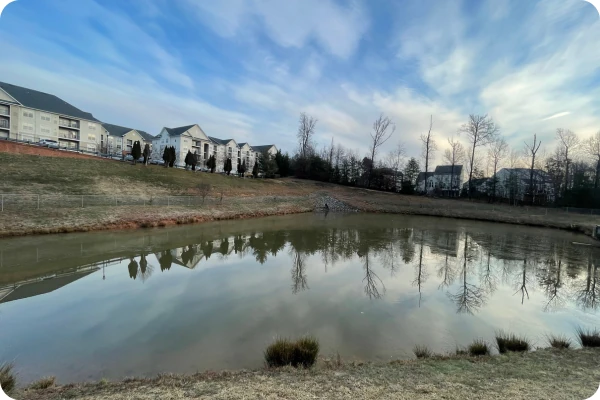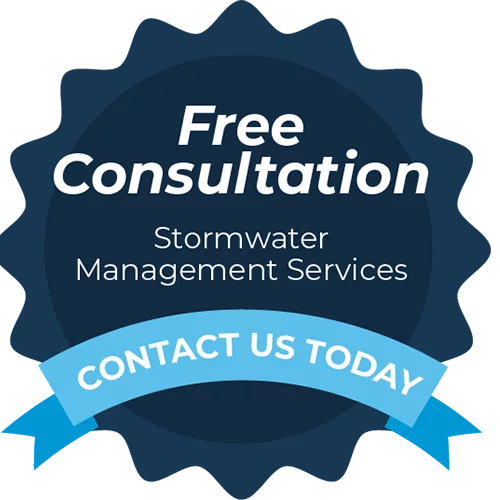Routine retention pond maintenance is crucial to prevent flooding, control pollutants, and ensure your stormwater pond remains functional and attractive. This guide provides essential steps to help you maintain a healthy, effective retention pond.

What Is a Retention Pond?
A retention pond, also known as a wet pond or stormwater management pond, is a permanent, water-filled basin designed to capture and treat stormwater runoff. Unlike detention ponds, which temporarily hold water and then release it slowly, retention ponds are meant to keep a constant level of water at all times. They collect and store runoff, allowing pollutants and sediment to settle at the bottom, while cleaner water gradually seeps into the surrounding environment or exits through a controlled outlet.
Retention ponds play a vital role in stormwater management by improving water quality, reducing erosion, and helping to control flood risks. Often found in residential communities, commercial properties, and industrial areas, these ponds help protect nearby waterways from contaminated runoff while creating a stable aquatic environment that can support plants and wildlife.
Why Retention Pond Maintenance Matters
Routine retention pond maintenance is critical for keeping stormwater ponds functional and environmentally friendly. Regular upkeep prevents sediment buildup, controls vegetation, and stabilizes pond embankments. Without regular maintenance, retention ponds can lose capacity, increase flood risk, and release pollutants into surrounding ecosystems.
Key Benefits of Regular Retention Pond Maintenance
- Flood Control: Well-maintained retention ponds help manage large volumes of runoff, preventing floods in nearby areas.
- Pollution Reduction: Regular sediment removal and vegetation control ensure pollutants don’t build up and enter natural water systems.
- Landscape Protection: Proper maintenance stabilizes channels and prevents erosion, protecting surrounding land.
- Aesthetic Appeal: A clean and well-maintained pond improves the appearance of a property, contributing to higher property values.
Who Is Responsible for Retention Pond Maintenance?
The responsibility for retention pond maintenance usually depends on ownership:
- Public Retention Ponds: Local governments or municipalities maintain ponds within public spaces or roadways.
- Private Retention Ponds: Property owners, HOAs, or management companies are typically responsible for retention ponds on private property, including those in residential communities, office parks, or shopping centers.
If you’re uncertain about your pond’s maintenance obligations, check with your local stormwater department or review property documents for ownership details.
Common Retention Pond Maintenance Challenges
Even with regular care, retention ponds can experience problems that impact their effectiveness:
- Sediment Buildup: Pollutants and debris from runoff settle on the pond bottom, reducing capacity and increasing flood risk.
- Erosion: Weather and other factors can erode pond embankments, compromising the pond’s stability.
- Vegetation Overgrowth: Uncontrolled vegetation can interfere with water flow, blocking drainage channels and affecting water storage.
iSTORMWATER provides expert retention pond services to address these challenges. Contact us at (410) 231-3455 for assistance in DC, MD, and VA.
Retention Pond Regulations to Know
In addition to federal Clean Water Act regulations, state and local laws often govern retention pond construction and maintenance. Maryland and Virginia, for instance, have specific stormwater management acts. A professional stormwater maintenance company like iSTORMWATER can help you navigate these regulations to ensure full compliance.
How to Perform Effective Retention Pond Maintenance
A comprehensive retention pond maintenance plan involves several routine tasks to keep the pond functioning optimally:
- Inspections: Regular inspections are crucial for catching issues early. Schedule them quarterly or annually, and after storms generating more than 1 inch of rain. Inspections should include checking for debris, erosion, and any blockages affecting drainage.
- Sediment Removal: Sediment should be removed every six months or whenever it reduces the pond’s original design depth by more than 25%. This process helps maintain the pond’s capacity and prevents pollutants from accumulating.
- Vegetation Management: Monthly mowing helps maintain the pond’s appearance and prevents erosion. Keep vegetation controlled around the pond’s edges, but avoid excessive use of fertilizers or pesticides, which can wash into the pond and degrade water quality.
- Mechanical Equipment Checks: Any mechanical components, such as valves, pumps, gates, and locks, should be inspected periodically to ensure they’re functioning correctly. This is particularly important for retention ponds with active control structures.
- Structural Repairs: The structural components of the pond, including embankments, inlet, and outlet structures, should be checked regularly for wear and damage. Timely repairs prevent further degradation and help the pond meet local and federal standards.
Why Retention Pond Maintenance Is a Smart Investment
Investing in retention pond maintenance protects your property, reduces environmental impact, and ensures compliance with local laws. Here’s why ongoing maintenance is worth it:
- Prevents Flooding: By maintaining pond capacity and function, you lower the risk of flooding in heavy rain events.
- Protects Water Quality: Regular sediment removal and controlled vegetation reduce pollutant levels, preventing contamination of nearby water bodies.
- Supports Ecosystem Health: Well-maintained retention ponds create habitats for local wildlife and plants, promoting biodiversity.
- Avoids Costly Repairs: Proactive maintenance can prevent minor issues from escalating into expensive repairs.
- Enhances Property Value: A well-maintained pond is an attractive feature that adds value to the property and appeals to both residents and visitors.
Get Expert Retention Pond Maintenance Help
If your retention pond requires sediment removal, structural repairs, or you’re navigating complex regulations, professional help is often the best solution. iSTORMWATER provides over 20 years of experience in pond management and offers a satisfaction guarantee for all maintenance services. Our team can handle routine maintenance, repairs, and emergency services, ensuring your retention pond remains in top condition.
Call us today at (410) 231-3455 or contact us online to schedule preventative or emergency stormwater pond maintenance in DC, MD, and VA.
Real Results
iStormwater LLC was an excellent choice. They made the process of the Stormwater pond repairs seamless. They took charge of the project and got the project approved and passing the inspection. We highly recommend them and would use them again.
Incredible stormwater management service. The owner John consulted on a property I manage and ended up saving us thousands of dollars in environmental fees from the government. Now, our property is compliant with the EPA and we have a great partner to keep us maintained on stormwater regulations over time.
So helpful with all of my water issues.
Great communication and leadership and a family friendly atmosphere. Thank you John!
Washington, DC's stormwater challenges are unlike those in many other regions. With dense urban development, historic neighborhoods, and aging infrastructure, managing stormwater runoff is both...
- Annapolis
- Anne Arundel County
- Baltimore County
- Baltimore
- Bel Air South
- Bethesda
- Bowie
- Cecil County
- Charles County
- Columbia
- Gaithersburg
- Glen Burnie
- Howard County
- Montgomery County
- Pasadena
- Prince George’s County
- Rockville
- Severna Park
- St. Mary’s County



